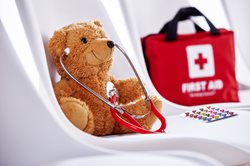(9/26/2022)
Planning a children’s hospital requires deliberate decisions at every turn. Each design element is an opportunity to make the children in treatment and their support teams feel safer and more comfortable within the space.
Creating a better environment for patients, and particularly pediatric patients, can have a strong impact on treatment outcomes. In fact, for the first time in history, there are more patients with congenital illness over the age of 18 than under, which is indicative of extraordinary advances in pediatric medicine and facilities. Continuing to support the health of infants, children and adolescents means taking their needs into consideration while designing healthcare facilities for them.
 Take a patient-centric approach
Take a patient-centric approach
Intentional choices shape an environment of care that is supportive of children and their comfort, helping to lessen their anxieties about being in a new place and going through unfamiliar procedures. The goal should be to capture the fun and energy of that stage of life within the walls of the hospital.
As always, teams should rely on evidence-based design elements, such as natural light. But establishing a kid-friendly environment means catering to child-specific needs and recognizing that the work of children is play. Elements throughout the hospital should support play across all age groups, from infants to adolescents, and pull in their curiosity. Your facility can promote outside play by integrating secured age-appropriate playgrounds within the hospital grounds.
Facility management teams should also allow children themselves to decide what they like and what is scary to them instead of assuming. For example, when Valley Children’s Hospital in California was constructing their new facility, they formed a committee of children with congenital or chronic illnesses who visited the hospital often. Since these patients were familiar with the design of the current hospital, they were able to make suggestions for what could be improved. One important recommendation the adult designers hadn’t considered was capping the hospital at two stories so it would be less intimidating.
Incorporate subtle yet critical elements
Certain elements can make the space more kid-friendly, such as catering to shorter attention spans and encouraging eye-level interactions by lowering reception desks and bringing down the overall scale of the space.
Many of these design decisions come down to balance. The use of color throughout the facility, for instance, should create a harmony between energy and calmness. Sculptures and colorful artwork can engage children and help them remember their way around and build confidence, while earthy tones in some spaces can ease anxiety. Additionally, incorporating softer textures that are able to remain clean can encourage comfort while preventing the spread of infections. One of the most difficult balancing acts is trying to please both children and parents by incorporating the elements they each find important. Keep in mind that making the children more comfortable will naturally help the parents, as well.
New technology also offers the opportunity to create a more kid-friendly environment. Some hospitals have built fiber-optic networks into the ceilings that twinkle like stars to bring calmness to children, while others have installed interactive games in lobbies and public spaces for a highly sensory and engaging experience while children wait.
Plan for specific groups
Pediatric hospitals often serve a vulnerable immunosuppressed patient population, so infectious disease protocols become even more important. Today, voice-activated technology and other features are popular to prevent infection transmission. Offering protected indoor and outdoor spaces for these patients is essential, especially knowing that green space is critical to the health and well-being of children.
Children in intensive care also tend to bring large support teams with them, which means adequate family and interactive spaces are essential. Parents or caretakers are typically under immense stress and should have spaces that will help them feel more relaxed.
When we create optimal settings for pediatric care, we are supporting the next generation by improving their health outcomes. As we continue to design hospitals around children’s needs, we can encourage more positive patient care experiences.
To learn more about the specific considerations that go into building a children’s hospital, check out Season 2, Episode 11 of our podcast,
Outside the Patient’s Door: “
Building a Child-Centric Children’s Hospital with Todd Suntrapak and Mike Wood.”